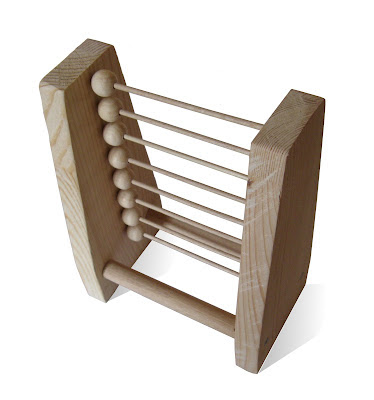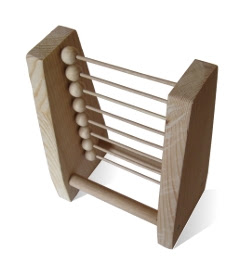
Dr. Emmett L. Brown: “Please excuse the crudity of this model, I didn't have time to build it to scale or to paint it.”Every once in a while, it helps me to do something that is totally unrelated to the field of Software Design. In my case I like to make the occasional wooden thing. In this case, related to my previous blogpost, I decided to build a binary abacus.
Just to elaborate, a binary abacus is a abacus where each row has only one bead (which simplifies the design, even if it complicates the arithmetic for normal people). A picture of an abacus with all eight beads live, giving a maximum value of 255, is visible on the left.
Ingredients
- some wood, 1.8 cm thickness
- a cylindrical piece of wood, 15 mm thickness, 1 meter length which is too long, really.
- a cylindrical piece of wood, 3 mm thickness, 1 meter length which is only just enough, so be carefull there
- wooden beads, 15 mm diameter, exactly 8.
- 4 or 6 screws (I used 40mm/3.5mm screws)
Utensils:
- a hacksaw
- old fashion woodsaw
- glue (ended up not using it after all, depends on what you want)
- sandpaper
- tapemeasure (essential)
- drill (3 mm and 4 mm)
- pencil
- screwdriver
- paper
- eraser
- hammer
Schematic
The Making Of
Use the hacksaw to saw the cylindrical pieces of wood to the proper length. The support beams should be 11.5 cm. The bead rows should be 12.5 cm. Do not worry overmuch if the bead rows are a little too short or a little too long, a couple of mm isn't going to make much difference. Be careful though, the wood is quite brittle.
Cut up a piece of paper in the proper dimensions and then use that to indicate where to saw the wood, with the woodsaw.
Saw the wood into the proper shapes. You should end up with two identical rough wooden Trapezoids.
Drill the 16 3mm holes at 20 mm distances approximately 7 mm into the wood.
Drill the 4 (6) 4mm holes all the way through for the support beams.
Use the sandpaper on both the Trapezoids to get the rough edges off. Go nuts, the more the better the result.
Drill 3mm holes into the opposite ends of the two (or three) support beams, to guide the screws.
Erase all the pencil drawings you did on the wood.
Fix all the bead rows into place on one of the trapezoids. You should be able to do this using only your hands.
Add the support beams to the trapezoid.
Add the beads to the bead rows. Important! You don't want to find out that you have a perfect abacus but forgot to add the beads.
Have fun trying to get them properly aligned with the other trapezoid.
Screw support beams securely together, after everything seems properly fixed.
Small soft taps with a hammer (covered in cloth) to make sure the bead rows are secure.
Good luck!
Notes
Make sure that the beads can slide smoothly over the 3mm thick cylindrical piece of wood.The hard part was getting all the rows to align properly against the holes in the wood.
I ended up using no glue at all, as the thing seemed pretty solid eventually.
Expansions
Possible extentions to the design are a red bead to indicate data overflow and some indications on the side on what's what. I was thinking along the lines of (from top to bottom) LSB 1, 2, 4, 8, 16, 32, 64, MSB 128.
In the example above, I used two supports at the bottom of the abacus. For maximum strength, you'd ideally wish to have a third support at the top somewhere.
And of course, some paint or some varnish will help.






